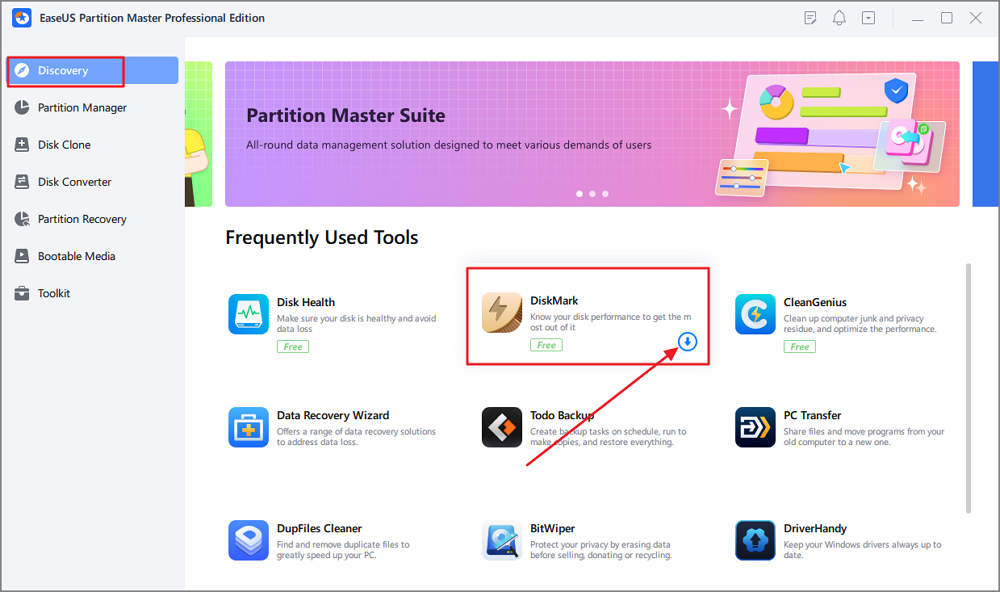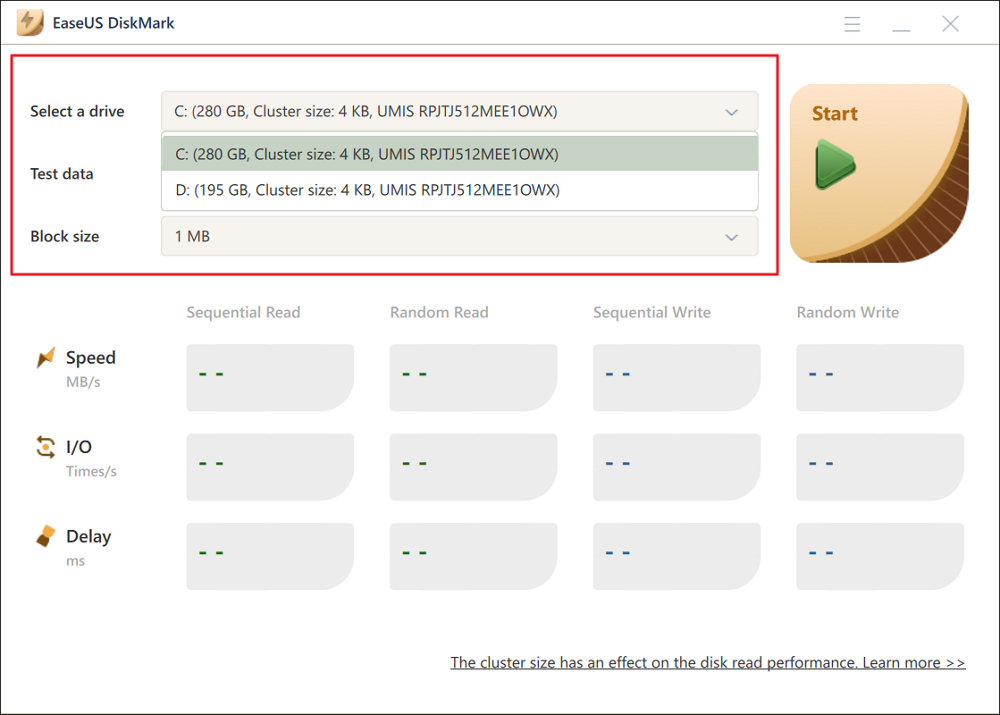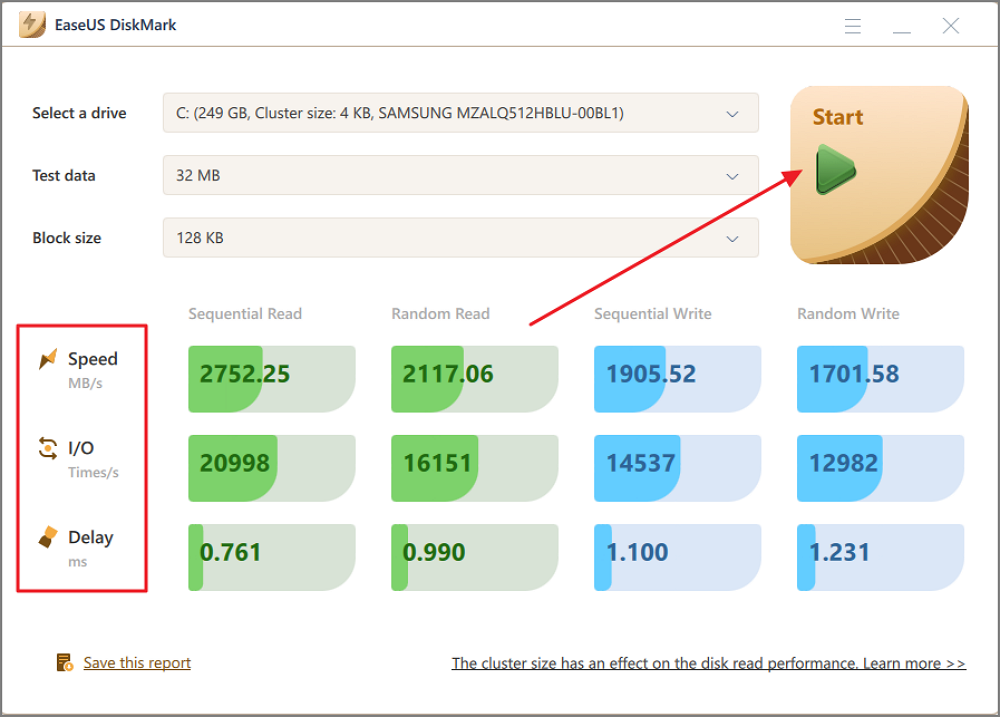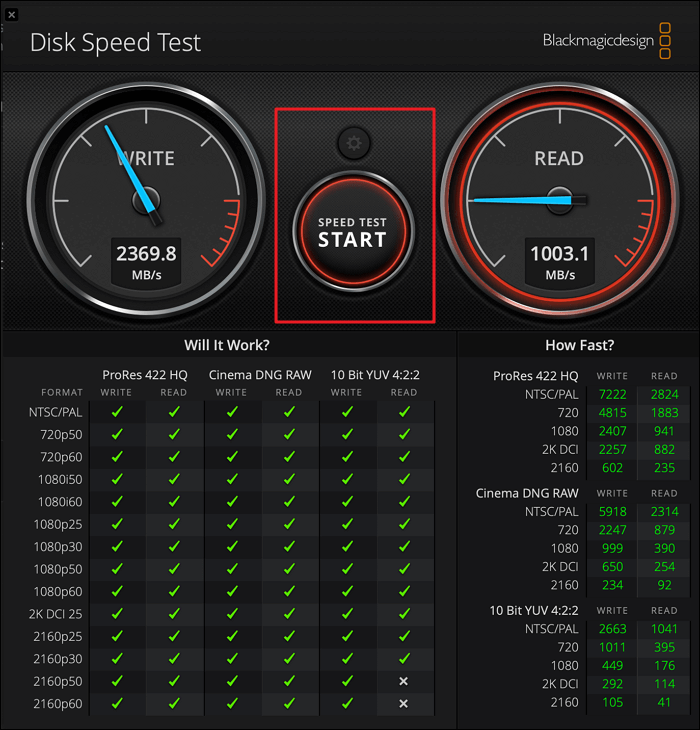Page Table of Contents
About the Author
Hot Topics
Updated on Jan 10, 2025
NVMe SSDs are among the fastest storage drives in the computing world. If you have recently installed an NVMe SSD on your system, running a disk speed test to test NVMe I/O speed can help determine improved computer performance. The I/O speed will allow you to determine how fast your system can transfer files across different storage devices.
Don't worry if you don't know how to run an NVMe speed test. Stick with the article to learn how to easily and accurately test NVMe I/O speed on Windows and Mac.
What Is NVMe I/O Speed
In the world of computers, the I/O speed refers to a computer's input and output speed. It is the representation of how much data a computer can transfer between its processor and its input/out devices in a specific time. A computer's input/output devices include hard drives, USBs, and other similar devices. The I/O speed is usually measured in input/output operations per second or IOPS.
For I/O speed, the "I" means input, representing the rate at which data can be transferred to a computer. In comparison, the "O" means output and refers to the data transfer rate from a computer to an output device. To make it simpler, for NVMe, the I/O speed means the number of input/output operations it can perform in a second. Higher the I/O speed, the better the NVMe performance.
How Do I Test My NVMe I/O Speed On My Own?
Testing the I/O speed of your NVMe is not difficult and can be done through reliable disk speed software or the operating system's inbuilt tools. Professional speed test software are recommended as they are easier to use and provides accurate results. Below are three methods to test NVMe speed for Windows and Mac:
The first two methods are for Windows users only, while the third is recommended for Mac users. Among these methods, using CMD will not require you to use a third-party app, but its command-line interface makes it unsuitable. Accidently running wrong commands can also harm your computer's operating system. That's why, for Windows, it is best to use EaseUS Partition Master to test NVMe I/O speed.
#1. Test NVMe I/O Speed with EaseUS Partition Master on Windows
EaseUS Partition Master is the best disk speed test software available for free to test NVMe I/O speed on Windows. This tool will provide accurate and detailed speed results to help determine your NVMe SSD's performance. It has a dedicated feature called “DiskMark,” which is the perfect tool to test the speed of storage drives like NVMe, M.2, SSD, HDD, USB, etc.
When using EaseUS Partition Master to speed test your NVMe drive, it will provide the results using read/write speed. I/O speed and delay speed metrics. What do these metrics represent? Read below to find out more:
- Read/Write Speed: The read/write speed of your NVMe drive will inform you about the time it takes to read or write a certain size of data in a given time. It is usually measured in MB/s or GB/s, and a higher read/write speed represents a faster drive.
- I/O Speed: As explained before, the I/O speed of your NVMe SSD represents how many input or output operations it can perform per second. The higher I/O speed is an indicator of high performing hard drive.
- Delay Speed: Your NVMe SSD's delay speed will indicate the time it takes to access the stored data. It is also known as latency rate and is measured in milliseconds or microseconds. A faster NVMe drive will have a lower delay speed.
Steps to Test NVMe I/O Speed Via EaseUS Partition Master
Due to its clean and intuitive interface, it is not hard to use this tool to test NVMe I/O speed. Use these steps to test NVMe I/O speed using EaseUS Partition Master:
Step 1. Launch EaseUS Partition Master. And click the download button to activate the "DiskMark" feature under the "Discovery" section.

Step 2. Click on the drop-down box to choose the target drive, test data, and block size.

Step 3. Once everything is configured, click "Start" to begin the disk test. Then, you can see the Sequential or Random read/write speed, I/O, and Delay data.

#2. Test NVMe I/O with CMD Command Line
The Command Prompt on Windows is also a great way to test NVMe I/O speed. However, using CMD can confuse non-regular users due to its command-line interface. To check the I/O speed of your NVMe SSD, you will need to use a WinSAT command. Follow the steps given below to test NVMe I/O speed with CMD on Windows:
Step 1: You will need to run the CMD as administrator on Windows to test NVMe I/O speed. For that, first, use the "Win + R" key to open the Run function. Here, type "cmd" and use the "Ctrl + Shift + Enter" key to launch CMD as administrator.

Step 2: Once the Command Prompt is open, run the following WinSAT command line:
“winsat disk -ran -write -drive Z” (Replace the “Z” with your NVMe drive name)
Wait for a while, and you will be able to seed the I/O speed of your NVMe SSD.

#3. Run and Test NVMe I/O Speed on Mac with Blackmagic Disk Speed Test
Want to know the best tool to test NVMe I/O speed for Mac? Blackmagic Disk Speed Test is an excellent lightweight and free tool available on Mac to test the speed of storage drives. This tool is completely safe and has a clean and simple interface. The steps required to test NVMe I/O speed via Blackmagic Disk Speed Test on Mac are given below:
Step 1: Use the Apple Mac App Store to install Blackmagic Disk Speed Test on your Mac and open it. If you want to run the speed test with the default stress value, hit the "Speed Test Start" button.
Step 2: To change the stress value, first tap the "Gear" icon to select a value and then click "Speed Test Start". After the test, the result can be saved using the gear icon and selecting the "Save Screenshot" option.

Final Verdict
Knowing how to test NVMe I/O speed ensures you know how much your system's performance has improved. If it isn't up to the mark, it can indicate a faulty NVMe SSD or other issues in your system. That's why EaseUS Partition Master is the best choice on Windows, as it will help resolve disk issues and provide accurate speed scores. For Mac, Blackmagic Disk Speed Test is the best choice.
FAQs About Testing NVMe I/O Speed
If you want to know more about how to test NVMe I/O speed, we have answered some FAQs about it below:
1. How do I run SSD read/write speed test online?
No, it is not possible to check the read/write speed of an SSD online. Given that SSDs are hardware components, you will need to download speed test software on your system. For Windows users, the best free SSD speed test software is EaseUS Partition Master, while for Mac users, it is Black Magic Disk Speed Test.
2. How do I test my NVMe performance?
To check how well your NVMe SSD is performing, you can run a disk speed test by using the following steps on Windows:
Step 1: Use the search bar on Windows to search Command Prompt and click “Run as administrator” to open the CMD with admin privileges.
Step 2: Now use the “winsat disk -ran -write -drive (name)” to check the performance of your NVMe.
3. How fast should my NVMe be?
The NVMe SSDs are among the fastest storage drives in the market. Their optimal speed depends upon the generation of PICe your NVMe SSD has. The most commonly used NVMe SSD PICe G3 should easily exceed the 3000 MB/s speed. An NVMe SSD PICe G4 has a speed of over 7500 MB/s.
How Can We Help You
About the Author
Updated by Tracy King
Tracy became a member of the EaseUS content team in 2013. Being a technical writer for over 10 years, she is enthusiastic about sharing tips to assist readers in resolving complex issues in disk management, file transfer, PC & Mac performance optimization, etc., like an expert.
Product Reviews
-
I love that the changes you make with EaseUS Partition Master Free aren't immediately applied to the disks. It makes it way easier to play out what will happen after you've made all the changes. I also think the overall look and feel of EaseUS Partition Master Free makes whatever you're doing with your computer's partitions easy.
Read More -
Partition Master Free can Resize, Move, Merge, Migrate, and Copy disks or partitions; convert to local, change label, defragment, check and explore partition; and much more. A premium upgrade adds free tech support and the ability to resize dynamic volumes.
Read More -
It won't hot image your drives or align them, but since it's coupled with a partition manager, it allows you do perform many tasks at once, instead of just cloning drives. You can move partitions around, resize them, defragment, and more, along with the other tools you'd expect from a cloning tool.
Read More
Related Articles
-
Best Bootable Disk Wipe USB Free Download 2025🚩
![author icon]() Sherly/2025/01/10
Sherly/2025/01/10 -
How to Fix 3DS Could Not Detect SD Card in 6 Ways
![author icon]() Tracy King/2024/10/31
Tracy King/2024/10/31 -
6 Tips to Fix SD Card Slow Transfer Speed on Windows
![author icon]() Tracy King/2024/10/29
Tracy King/2024/10/29 -
HP USB Disk Storage Format Tool Portable Free Download 🔎
![author icon]() Sherly/2024/11/20
Sherly/2024/11/20
Hot Topics in 2024
EaseUS Partition Master

Manage partitions and optimize disks efficiently








